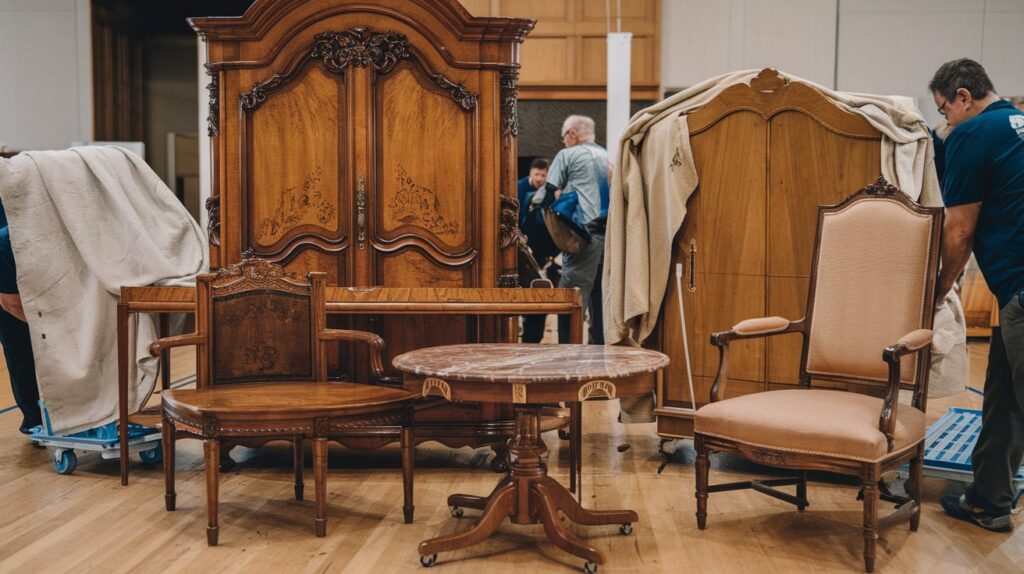Transporting antique furniture is a task that requires special care and planning. Unlike modern interior items, rare and old items have not only material value but also historical value. Any crack, chip, or loss of a decorative element can significantly reduce their value and uniqueness. That is why move collectibles must be based on strict adherence to the rules of packaging, loading, and transportation. In this article, we have compiled 11 practical tips to help you transport antiques without damaging their appearance.
Tip 1. Conduct a preliminary assessment of the condition of the furniture
Before you start packing, make sure you have all the necessary tools and materials:
- packing paper
- bubble wrap
- cardboard boxes
- duct tape
- tools for disassembly.
It is also important to inspect the interior item before transport. Note any existing damage: cracks, chips, signs of restoration. Take photos to record the condition. Identify which items require special care and show them to local movers in Los Angeles. This approach will help you understand what to pay attention to.
Tip 2. Use the right packing materials
Don’t just use newspapers or old rags. To move Antique Furniture without damage, you need special packing materials:
- soft foam
- stretch film for securing
- special fabric covers.
Each layer of packaging should serve its own purpose: the first layer protects against scratches, the second layer cushions impacts, and the third layer ensures airtightness. Wrap each item in bubble wrap or soft packing paper.
Tip 3. Disassemble furniture if possible
If possible, disassemble the item by removing legs, backs, or other removable parts. Pack them separately in soft materials. Label each part to simplify reassembly. When disassembled, any item is easier to transport and less susceptible to mechanical damage.
Tip 4. Protect corners and protruding parts
The corners of antique structures are the most vulnerable areas. To keep them intact:
- use special foam corners
- wrap protrusions with thick cardboard
- secure an additional layer of film on top.
This protection will help avoid chips from accidental impacts during the move Antique Furniture without scratch. For luxury items with unusual shapes or finishes (lacquer, wax), use specialized packaging materials.
Tip 5. Plan your route in advance
The right logistics are just as important as the packaging itself:
- Choose the right size of transport.
- Think about how the decorative items will be carried out and brought in.
- Check with the transport company to see if they have experience with antiques.
Proper route planning reduces the possibility of damage during loading and unloading.
Tip 6. Don’t overload antique furniture
When loading items into a vehicle, make sure you don’t overload it. If items are packed too tightly together, this can cause damage during transport. Place large items at the bottom and lighter, more fragile items on top.
Tip 7. Use fasteners inside the vehicle
Even the most reliable packaging will not save you if the furniture moves freely in the cargo area.
- Use straps and fastening slings.
- Position items so that they do not come into contact with other items.
- Make sure there are no sharp metal elements in the cargo area.
Fixing when you move Antique Furniture is a necessary step during sharp turns to keep historical interior items in place.
Tip 8. Keep things in the best condition during transport
Antiques are sensitive to changes in temperature and humidity. Don’t transport items with history in the rain without protection. In hot weather, avoid direct sunlight. In winter, choose a car with climate control. These measures will help prevent wood deformation and damage to the finish.
Tip 9. Inspect the new address in advance
Before transportation, it is a good idea to familiarize yourself with the new location. Find out what difficulties may arise during transportation. These may include narrow corridors or high stairs.
Safety transporting Antique Furniture involves securing doors and drawers. They should not be able to open. Remove keys, handles, and small decorative elements.
Tip 10. Supervise the process yourself
Even if you trust professionals, supervision is necessary. Make sure everything is done properly. Furniture movers in Los Angeles lift interior items with history correctly, rather than dragging them around. Specify where and how exactly it will be installed in the vehicle. As a rule, professionals are open to dialogue and satisfy customer requests.
Tip 11. Get cargo insurance
Even with perfect preparation, no one is immune to unforeseen situations. Get insurance before transport. Make sure the insurance company takes into account the actual value of the artwork. Keep all evidence with you from the moment of loading and after.
Why do you need a professional team to move your furniture?
Moving furniture seems like a simple task. However, it requires experience, reliable equipment, and the right materials. That is why it is better to entrust this process to professionals. 5 Points Moving offers a full range of services: careful disassembly, careful packing, and safe transportation to the destination. By choosing a team of professionals, you save time and effort.
Final thoughts
Transporting interior items, especially antiques, requires knowledge, care, and a professional approach. By entrusting this important stage to an experienced team, you protect yourself from unnecessary costs and keep your luxury items in perfect condition. The professionals at 5 Points Moving can anticipate risks and use high-quality materials and reliable transportation methods. After all, the most important thing about moving is not just transporting your belongings, but starting a new life without unnecessary worries.

